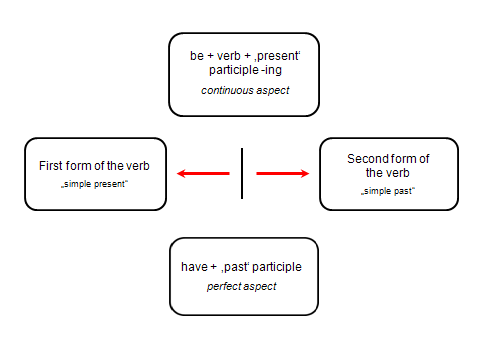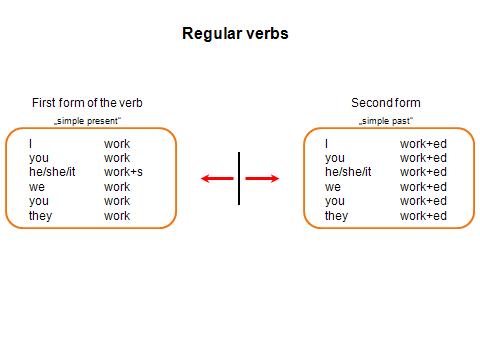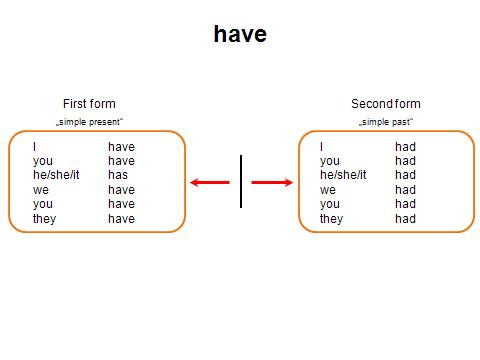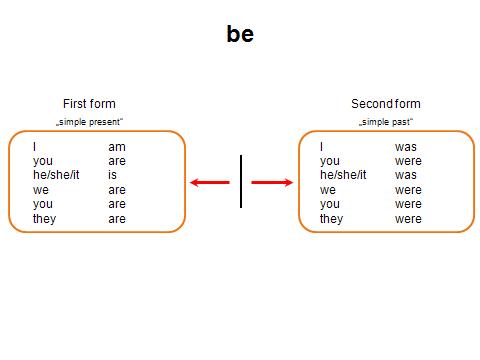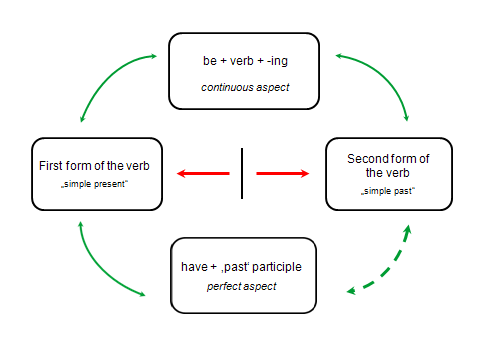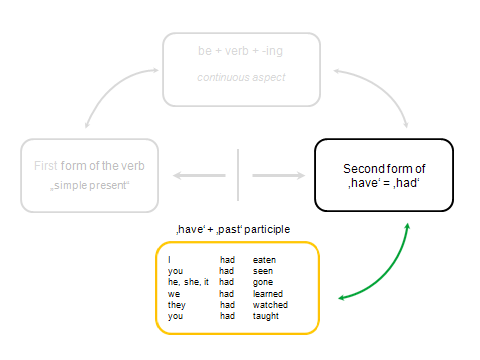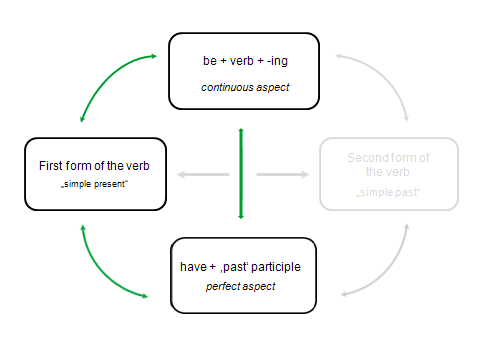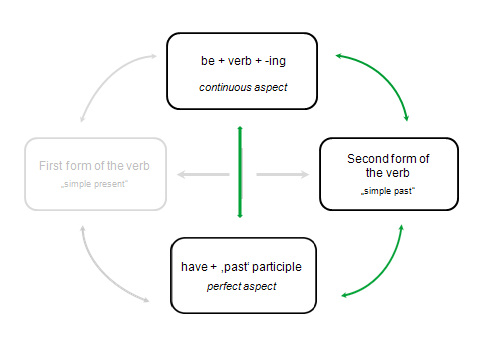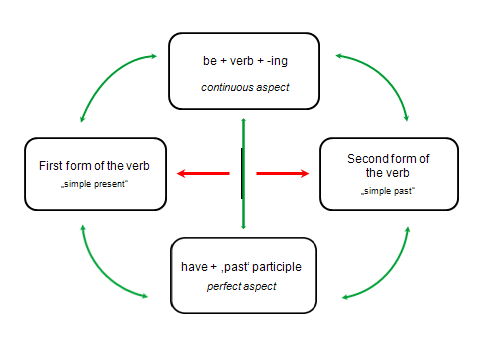The Verb Structure Circle and its Basic Building Blocks: an overview of the English verb structure system
I developed this overview of the English verb structure system as an attempt to give students of English a simplified and, as I hope, more easily comprehensible, summary of the English verb system. It is meant for those who have managed the basics of the system, but still feel insecure in fully comprehending the different forms and their meanings and use. It is meant to demonstrate the regularity of the system, doing away with the notion of ‘exceptions’ as much as possible.
Note to teachers: Whenever I give my students this kind of overview of the English verb structure system, I do it on a big white-board. A big board of any kind is essential if you want to have the whole overview in one graphic, and demonstrate visually how the four basic forms combine.
The modal auxiliary system (modal auxiliaries would, will, can, could, should, (shall), must, may, might) will be explained separately, as will questions and negation, ‘going to’, ‘have to’, and ‘want to’.
Here I would like to concentrate on the four basic forms of the English verb as seen below in figure 1:
Figure 1
I have arranged these four basic forms in a circle. Many summaries of English verb structures offer long lists of different forms, and often students come to believe all these are different tenses (see introduction). A closer look will reveal that all these listed verb structures are combinations of the four basic forms above (excluding structures formed with modal auxiliaries – will, would, can, could etc. – which I will treat separately).
These long lists tend to be overwhelming. I also believe that they do not capture the strict regularity of the English verb structure system. This regularity is what I intend to demonstrate here.
I also want to get away from the notion of linearity (of time). Students come to believe that the different verb structures (commonly called ‘tenses’) semantically express time; ‘time’ most commonly meant to refer to linear time: present, past and future. This is not the case as I intend to show.
Trying to explain the English verb forms in reference to linear time leads to a lot of confusion when it comes to understanding the meaning of the four forms above. The reason for this is simple: its not correct. Only one form really refers to time in its most frequent use: the second form or ‘past tense’.
I have come to find that a circular arrangement of the four forms can capture the systematicity of how they work together quite nicely and definitely better than a list of all possible verb form combinations.
The First Form (or ‘simple present’) and the Second Form (or ‘simple past’) of the English Verb
I will go through all forms in a succession of slides, the first of which presents that combination which is not possible. Because of their respective meaning(s), these two forms are mutually exclusive: they cannot be combined.
Figure 2
A verb – any verb (main verb or auxiliary have, be, or do) is either in the first form or in the second, as demonstrated in figures 3, 4, 5 and 6. (More about do when we talk about questions and negation.)
Extra note (skip in case you find it confusing or too much information for the time being)
Some might object here and note: “Wait a minute, what about the third form? We all learned go – went – gone; see – saw – seen; look – looked – looked etc.” True, not to forget the -ing form. If you look at the first and second slide again, you find these two forms as components of what is linguistically commonly referred to as aspects of the verb: the continuous or progressive aspect and the perfect aspect. In the two slides above they are the second part of these forms and referred to as ‘present’ participle – the verb+ing as in looking e.g. – and ‘past’ participle’ as in seen, gone, looked etc. respectively. They are not verb structures or forms in their own right, they are parts of a longer or slightly more complex structure than the first two simple forms and will be explained later. They combine with an auxiliary that itself is inflected for either the first or the second form. The participles themselves never change. When standing alone in a sentence i.e. without auxiliary, they take on different semantic functions: they become adjectives or nouns (gerunds).
Figure 3
The first form or ‘simple present’ is always the same except for the third person singular -s. The second form (or ‘past tense’) is marked by the addition of an -ed ending to the basic form (infinitive) in regular verbs.
Figure 4
‘Have’ changes once in the first form (simple ‘present’) when it changes to has in combination with he, she or it. It functions either as a main verb in the sense of expressing possession or in combination with fixed expressions like ‘have a shower’. As an auxiliary it is needed to form the present and past perfect structures. We come to those two later.
Figure 5
Figure 5 shows a list of some irregular forms. Their number is limited and they need to be memorized. I strongly believe if grammarians and language teachers left the English language alone, we would have lost some irregular forms by now and would say e.g. catched and teached or goed and seed as children regularly do when they develop English as their native or first language.
Figure 6
‘Be’, as its equivalents in many other languages, is special in that it changes more according to person than other verbs thus giving us am, are, is in the ‘simple present’ and was and were in the ‘simple past’. In this respect it is different from all other English verbs, auxiliaries and main verbs.
The MEANINGS (semantics) of the FIRST and the SECOND FORM
The semantics of the first form, commonly known as ‘simple present’
We use the simple form of the verb to express, for instance, things we do everyday, like when we get up in the morning, have breakfast or take a shower first and have no breakfast at all, or just a cup of coffee. We then usually go to work; we either drive by car or take the bus or go by bike. After work, we maybe go to a gym or play sports with friends or just relax with a book or in front of the television.
The simple form is also used in scientific texts or text books when expressing facts (or what the authors believe to be facts). Here some headlines from Scientific American magazine (August 2013):
How Reality Gets Created; Why Exercise Works Wonders; How Sleep Shapes Memory;
From the article on exercising:
Being active is good for us for many reasons beyond the old familiar ones. (…) Regular movement not only lowers the risk of developing or dying from heart disease, stroke and diabetes, it also prevents certain cancers, improves mood, builds bones, strengthens muscles, expands lung capacity, reduces the risk of falls and fractures, and helps to keep excess weight in check. (…) (p 68)
Notice that in all examples from Scientific American the verb takes an -s. But, as mentioned before, that is the only change we have in the first form of the verb.
What do all examples have in common or what seems to be the basic underlying meaning of the verb form? We commonly call it the ‘simple present’ or ‘present simple’ and you could perhaps argue that the content and claims of all sentences are true for the present. But when we talk about our habits or regular activities, the things we commonly do everyday or every week, we also did yesterday and probably will do tomorrow. Only, we are not talking about yesterday or tomorrow, we are talking about always or usually or generally, maybe even only about sometimes; we have or need no reference to a specific (linear) time of past, present or future.
Additionally, by using the first form of the verb, we express things we believe to be commonly true for us and our lives, or scientifically true, as e.g. in the article on exercise: here the authors are expressing things they believe to be general truths based on the research they are discussing.
In summary: regular activities, common knowledge, general truths, things we believe to be facts are what we express using the first form of the verb. Time doesn’t really factor in, it is of no concern in any of the examples. It is not expressed by the verb and therefore not part of its basic meaning (semantics).
If we wanted to add a concrete time, we would have to do so lexically:
I go to the gym on Mondays; my train leaves (everyday, so also tomorrow) at 6 am, I start work at 8:00 am etc.
Thus, we can say the main semantic aspect of the first form of the verb seems to be to express timeless factuality. Note that ‘factuality’ does not mean objective never-changing truth, but only that the speaker believes what he or she is saying is a timeless fact. Facts change, knowledge changes, and there is no objective truth anyhow. (Also note that most verbs in this paragraph are also in the first form, and I truly believe that what I have written is fact as far as my reasoning goes. See also Michael Lewis, 1983: The English Verb, Chapter on ‘The First Form’.)
The semantics of the second form, commonly referred to as ‘past tense’
Whenever an activity, event, state of mind etc. I want to talk about happened in a time before the moment of speaking (some time in the past) or I thought was a fact some time in the past, but no longer, the verb takes on an -ed or – in cases of irregular verbs – its respective second form. Often the time of the event is stated in more or less detail lexically, but not always.
Yesterday I got up earlier than usual, had eggs for breakfast instead of cereal. I missed the bus so was late for work. My colleague spilled coffee over my desk and I knocked his bottle of water off the table etc.
All things truly happened the way I am telling them, unless I am making up a story (or lying); in any case, we use the ‘past tense’ to express facts in the past. We either believe they were true (or factual) or want the person we are speaking to to believe they were true – objective truth is not the point.
From the perspective of time, the event we are talking about (or feeling, scientific fact, discovery in the past etc.) happened removed from now, removed from the present time of speaking back to some no longer present time. This is important and a semantic aspect of the second form Michael Lewis (1983) describes as ‘remoteness’ – in this case: remoteness in time. I find the concept of remoteness (or distance) quite useful for capturing the semantic core of the ‘past tense’ or second form of the verb, as it fits all other forms of its use, thereby making it unnecessary to talk of ‘exceptions’ whenever a use of the ‘simple past’ is not referring to past time.
If you take, for example, the hypothetical conditional statement commonly referred to as 2. conditional, you learn that the verb in the IF-clause is in the ‘past tense’ – no ‘would’ in the IF-clause is one of those haunting (school) rules when IF-clauses are taught.
I have often found some of my adult students struggling with understanding, let alone constructing, sentences like ‘If they went by train, they might get to the airport earlier’. It took me a while to realize it was the ‘went’ (or any other ‘past tense’ form) that was causing the problem. They had ingrained the meaning past time with the second form of the verb so strongly that other usages (or meanings) were blocked; they were interpreting the ‘past tense’ form as exactly what it was called – past.
Let’s look at some examples of conditional constructions using the first form of the verb in the if-clause and compare them with examples using the second form to exemplify the semantic differences between the two.
If I finish work earlier, I will go shopping for you.
If we have enough time, we can visit the museum.
If you eat more vegetables, you will feel better.
In each case, the fact stated in the first part of the sentence is the necessary prerequisite for the activity of the second to be possible or to happen; and it is possible – I just don’t know yet – that I might be able to finish work earlier to do your shopping. And it could be that we indeed have enough time for the museum, we just don’t know yet or for sure. The same with the last example: I’m giving you an advice and believe you might follow it, and if you do, I predict you will feel better.
All the ‘facts’ in all these examples are closer to becoming reality than in the following examples:
If we had enough time, we could visit the museum.
If they trained more efficiently, they would be more successful.
If you ate more vegetables, you would feel better.
In each case, the stated fact in the IF-clause is a fact necessary for the claim of the second clause to become true – in other words: a condition or requirement, but – other than the conditions stated in the first examples of the 1. conditional form – the facts here are further removed from becoming likely reality:
If we had time (but we don’t); if they trained more (but they don’t); if you ate more vegetables…(but you don’t).
This distance in reality is expressed by the second form of the verb and has nothing to do with past time.
Expressing distance in time is only one ‘distance’ the ‘past tense’ form is used for, and it could or would be helpful to change its name (though I don’t think that will happen, if I did, I would have used the first forms can and will).
The Continuous Aspect
The continuous aspect can be combined with all forms. However, I will start with its combination with the first and the second form.
The ‘simple present’ continuous and the ‘simple past’ continuous or: the continuous aspect in combination with the first form and the second form: figures 7 and 8:
Figure 7
Figure 8
Structurally, the main verb takes on an -ing ending and is preceded by a form of the auxiliary BE that changes according to person (I, you, he, she, it we, they). When it combines with the first form of the verb we get the forms you see in Figure 7:
When it combines with the second form of the verb, we get the forms you see in Figure 8:
What is the core meaning of the continuous structure?
Let’s look at some contrastive examples (here: continuous contrasted with simple forms):
I’m reading a very interesting book. I read TIME magazine.
In the first sentence, I am in the process of reading and have not finished yet. I am not necessarily reading at the moment of speaking. We often say things like: I’m reading a really interesting book at the moment without at the moment meant to be taken verbatim.
My reading of TIME magazine is not specified for time. The magazine is just something I am in the habit of reading. I could add an aspect of time lexically, like ‘regularly’ or ‘every week’.
“I can’t answer the door, I‘m taking a bath!” I take a bath every Friday evening.
Again someone is in the process of doing something, which – needless to say – is not over, but incomplete and definitely, in this case, of limited duration. These semantic aspects are essential to the situation and would always find their expression in the choice of the continuous form. Taking a bath every Friday, though, is, again, a general statement of a regular habit, specified for time by the phrase ‘every Friday evening’, not by the verb itself. In the first case: *I take a bath would not be an adequately formed English sentence. (An * precedes sentences considered not English, a preceding ? expresses the sentence is unusual, but maybe not totally off.)
She is drowning in work. She works overtime every day.
Hopefully, in the first case, her workload will change eventually. This is the current situation. Note again that ‘at the moment of speaking’ is not essential to the interpretation of the ‘present’ continuous’ meaning. The utterance ‘She is drowning in work’ could refer to a current moment of speaking, but the speaker could just as well say this while all involved are sitting in the cafeteria having lunch.
The reason I repeatedly point out this latter aspect is to make clear that the continuous form combined with the first form is not about present time. Many have learned to associate the ‘present’ continuous with present time, when the meaning or usage of this form is (or was) described to them as expressing something we are doing at the moment (of speaking). Though its core meaning allows us to use it in this way – I am writing now, at this moment, here, sitting at my desk, and I would have to use the ‘present’ continuous to express this if somebody called me on the phone and asked me what I was doing. Still, this is not the core meaning of the form as we have seen in other examples and can see in the next.
She writes popular novels. She‘s writing a sequel to her last book.
She probably is an author by profession. Writing books or novels is something she does without any specification for time. The second sentence also does not specify for time: it just expresses that her latest book is in progress and not yet complete.
The boy was drowning. The boy drowned.
Here the two situations are placed into the past – the second form here used for ‘distance in time’. In which of the two is the boy beyond hope?
He was leaving when we arrived. He always leaves when we arrive.
Some time in the past, somebody was in the process of leaving, so not gone yet. The second is a general statement of observation, true or not, the speaker claims it to be.
We were walking down the street when we suddenly heard a loud noise.
In narratives, the continuous is often used to describe a background situation (in progress, not complete). While we were walking down the street, something else happened.
To summarize: the core meaning of the continuous is to express an activity in progress (which is why the form is also sometimes called ‘progressive’). When we use it, we are focusing on the activity we are talking about. An activity expressed in the continuous form can be seen as temporary or of limited duration, and is seen as incomplete.
Note: what I call activity – the meaning of the verb – need not always be something really active. In the sentence ‘I am sleeping badly at the moment’ ‘sleeping’ is not an activity in the common sense of the word. Here the choice of the continuous form implies that ‘sleeping badly’ is not the usual state, it is a special situation and – hopefully – of limited duration.
In contrast, the sentence ?’We were living there for four years’, while not totally impossible, would sound awkward. ‘Live’, in the context of referring to a time of residence, has a rather static verb meaning (in contrast to so-called dynamic verb meanings). Static verbs are usually not used in the continuous form (and let’s ignore McDonalds ‘I’m lovin’ it’ here). ‘We lived there for four years’ would be the preferred choice when referring to how long we stayed in a certain place; the time we lived there is over the ‘activity’ finished.
Figure 9
The Perfect Aspect
The Perfect Aspect in Combination with the First Form of HAVE
Figure 10
The perfect aspect is a combination of the auxiliary HAVE with the so-called past participle of the main verb (the so-called present participle is the -ing participle). The ‘past participle is commonly also referred to as third form of the verb when learners of English memorize lists of irregular verbs; e.g. go-went-gone, see-saw-seen, write-wrote-written etc.
With regular verbs, the ‘past participle’ is the same as the second or ‘past-tense’ form: looked – looked – looked, walk-walked-walked, cook-cooked-cooked etc. With some irregular forms, the third form has the same form as the second: teach-taught-taught, catch-caught-caught.
These structural aspects are facts of the language and need to be memorized. However, since most irregular forms are highly frequent, memorizing them shouldn’t cause a big problem when learners get a lot of language input (and sit down with some vocabulary cards, a friend and classmate, or whoever would profit from practising verb forms.)
Figure 11
Semantically, the ‘present perfect’ combines past with present. Thus, it expresses or relates to aspects of time. This can mean various things best explained with examples.
A typical situation often comes up in companies when new members join a group and everybody introduces themselves and tells each other how long they have been with the company. Commonly, participants – especially Germans – say things like: *I work for XYZ since 2010 or *I am working for XYZ for 10 years (or *since 10 years).
In German, the ‘simple present’ would be used in this case (Ich arbeite für XYZ seit 10 Jahren), in English this would not be done; the reason being that we are talking about something that started in the past (10 years ago) and reaches up to now (I am still with the company, or at least have been until this moment of speaking, although they might have just fired me.)
This is what only the present perfect does: it combines something that started in the past with the present moment of speaking. This is achieved by combining the first form of the auxiliary ‘have’ with the ‘past participle’.
In this example, we could go one step further and add the continuous aspect (I’m still working for the company and intend to go on doing so). When combining the perfect aspect with the continuous, we would get: I have been working for XYZ for ten years.
The resultative ‘present perfect’
Sometimes the connection of past with present (moment of speaking) does not refer to the semantics of the verb. Especially in British English speakers say things like: I’m not hungry, I’ve already/just eaten. The eating itself is actually over, but the speaker uses ‘present perfect’ instead of ‘past tense’ because the activity has an immediate effect or relevance for the present moment. Americans here would most often use the second or past tense form: I already/just ate or: had something to eat.
This usage of the ‘present perfect’ is often called the ‘resultative present perfect’. It is the result of whatever action the verb expresses that matters for the present. Thus, if I say He has broken his leg, it is clear that the leg is still broken. In American English, we would say He broke his leg, as the moment of injuring is past. (I believe in general there would probably be little room for misunderstanding in these cases, when using the past form, as the context would most likely be clear, but British English speakers prefer the ‘present perfect’ in these situations.)
The resultative ‘present perfect’ often seems to cause problems for learners of English as it does not demonstrate the core of the form’s meaning so clearly and is not used consistently by all speakers of English.
I believe some examples of questions and negatives to demonstrate the meaning of the ‘present perfect’ much better than statements, as here we find cases where the form is necessary and its core meaning can be shown more clearly.
Typical examples would be asking someone if they have (already) done something:
Have you finished the report?
Have you ever been to Paris/London/Hawaii?
Have you seen him today?
Have you invited everybody to our party (yet)? etc.
In relation to time, the speaker is asking about a time span that started in the past and reaches up to now, because he or she does not know if the event or activity in question has indeed (already) happened.
If, in each case, the answer is ‘yes, I have‘ the answering party would, most likely, continue using the past tense:
I visited London last year;
I saw him in the elevator this morning;
I sent out the invitations last week etc.
(Note: in the latter case of inviting people to the party, the speaker could also say (and a British speaker would most likely do so): Yes I’ve invited everybody …… as there would be a link to the present. Everybody has received an invitation, they have one now (and hopefully will come).)
If the answer were negative – No, I haven’t – (and the speaker would like to add some information) he or she would stay in the present perfect:
No, I haven’t bought the invitation cards yet;
I haven’t had the time yet;
I haven’t seen him for days etc.
(I will discuss more examples in single posts)
Combining the ‘perfect aspect’ with the second form of the verb
Figure 12
Figure 13
When we combine the perfect aspect with the second form of the auxiliary verb ‘have’, we get the so-called ‘past perfect’.
A past perfect utterance always stands in relation to other things said or told referring to the past using the ‘past tense’ or second form. It is commonly used when we speak about a sequence of events and jump back in time, leaving the chronology of events reported.
To give an example:
I’m telling someone about a break-in in my house:
We left around 6:00 pm to meet our friends. We had tickets for the theater. (Great play, our seats were a little too far back, but the actors…blablabla). When we came back home, the front door stood open, I was absolutely sure
I had locked it when we left.
So here I am leaving the sequence of events – first this happened, then that, then ‘event 3′ etc. – to report something I had done before everything else happened.
This I believe to be the main semantic function of the ‘past perfect’ – I don’t believe it to be awfully essential and for German learners of English: it is used similarly to the equivalent German form commonly know as ‘Plusquamperfekt’ (wonderful Latin expression) or ‘Vorvergangenheit’.
We have almost come full circle. (Actually, we already do have a circle, but the combinatorial system is not yet complete.)
Figure 14
Combinations of Three: The perfect and continuous aspects with the first and second forms
We have combined the first form with the continuous and perfect aspects respectively, and done the same with the second form. Each combination was a combination of two.
In the next and last step, we will have two combinations of three.
As already mentioned, the continuous aspect, the -ing form, can be combined with all other forms. The aspect of an activity in progress can be expressed in combination with the first form, combining to form the so-called ‘present progressive or continuous’ and with the second or ‘past tense’ form to combine to the ‘past progressive or continuous’. It can also combine with all modal forms and passive constructions – these I will discuss in later pages.
Figure 15
What we get when combining the first form with the two aspects is what you see in figure 15: the auxiliary of the perfect aspect fulfills the grammatical function in that it changes its form according to grammatical person (for the third person singular have is changed to has), the auxiliary ‘be’ of the continuous aspect takes ‘past participle’ form (been), and the main verb is in the ‘present participle’ form (verb +ing).
Figure 16
Could we – just theoretically – imagine a different form of combination? Where e.g. the two auxiliaries swap position? In other words, is there a reason the forms combine the way they do? If we allow this question for a moment and play around we could form:
I am had eating;
You are had eating;
She is had eating etc.
Quite strange. For one, because it is uncommon. However, I could also imagine there to be a sensible reason for the order we have; for instance, not to separate the structural components of the two aspects; i.e. in the ‘correct’ constructions that form the ‘present perfect continuous’, the auxiliary ‘have’ is next to its accompanying participle (been) with the auxiliary ‘be’ being next to its accompanying participle (verb+ing). With the swapped constructions this would not be the case. So the way it is, we have an elegant solution for keeping the two aspects structurally coherent in one combined form.
And for the second possible combination of three we just change the form of ‘have’ to ‘had’ – the rest stays the same.
Figure 17
Figure 18
Now to the semantics of the two structures.
Let’s look at some examples:
We have been playing football together since we were kids;
I have been working for this company for many years;
She has been writing novels since she retired from her job…
In all sentences, according to the core meaning of the two aspects, the speakers are talking about time spans that started in the past and last until the moment of speaking and – in addition – express that whatever they started doing in the past is still in progress, ongoing or incomplete.
Another situation in which we would most likely always use the ‘present perfect continuous’ would be when we want to explain a current feeling or state e.g. why we don’t feel like doing something:
I don’t feel like going out tonight – I have been working all day.
I would carefully claim that the ‘past perfect progressive’ is a little less commonly used.
She had already been looking for a new job for a considerable time when she saw the ad ……
A speaker using this construction is changing the sequence of events in accordance with the basic meaning of the ‘past perfect’:
(1) she was looking for a new job
(2) then she saw the ad
She saw the ad (2) after she had been looking for a new job for a considerable time (1).
Figure 19
Basic system complete!


